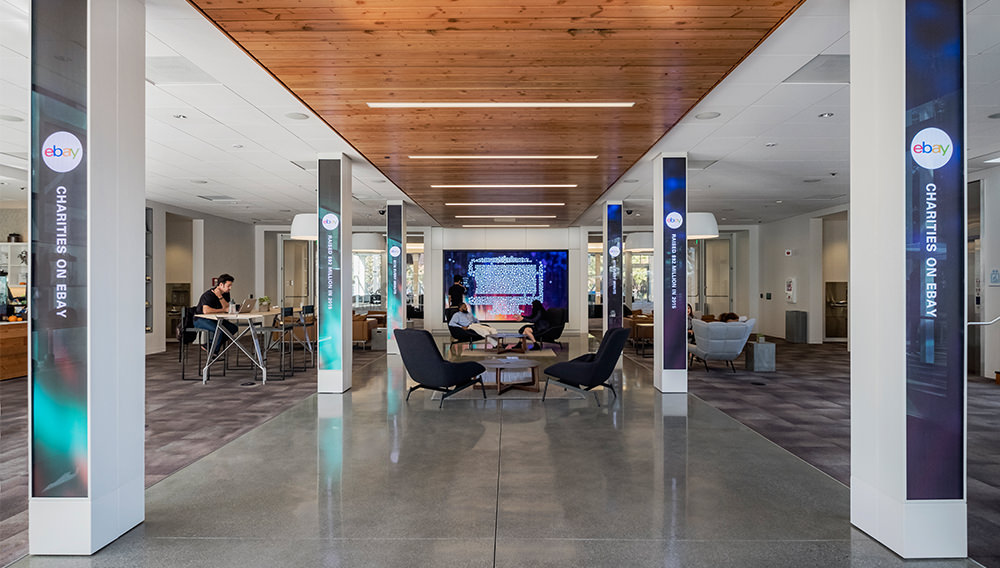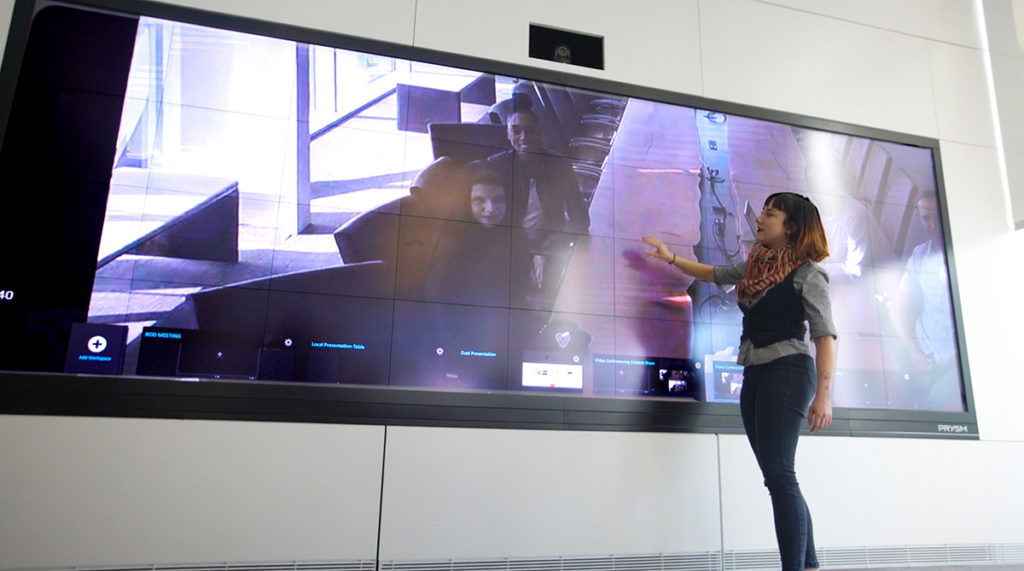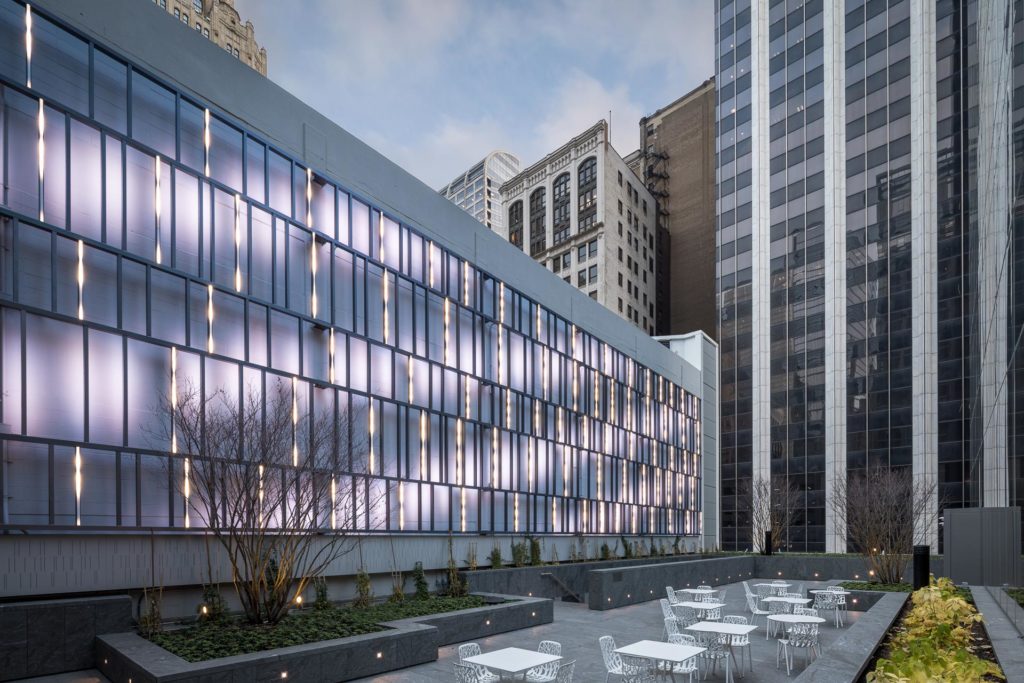How to Feel Together While We’re Apart
Posted August 19, 2020
Where Work and Collaboration Meet in the Era of COVID-19
–
This article is co-authored by ESI Design’s Emily Webster and NBBJ’s Andrea Vanecko.
In the traditional workplace during “normal” times, an employee’s presence is felt as soon as they step foot into the office. Yet in the era of COVID-19, where some are in the workplace and some are remote, employees risk feeling increasingly disconnected from each other. While some tech companies and startups have worked with a distributed workforce for a while, many more organizations now have to consider how to effectively adapt to this unique way of working.
Now is the time to experiment. After months of working remotely, our perspective about our work and our office experience has changed. As new work styles and environments evolve, it’s important to continually test how people truly use their space and connect with one another. Changes to process, policy and the physical design of a workplace can mitigate this sense of disconnection, of which we list a few ideas to consider below. But the first step is to consider company culture:
- How do employees, teams, departments and your organization work and meet? What are the daily patterns and rituals that make your company unique?
- How do collaboration rhythms impact roles and departments that are more independent, versus others that are more team-based?
- Does your company provide services to clients or produce internal products? Is your work on display or private?
- How do you share exciting moments?
Answering these questions will highlight habits and perspectives that are central to an organization and reveal ways to carry these cultural benefits forward through the coronavirus and beyond. With these questions answered, the following design strategies can be integrated to create an environment of social cohesion, productivity and collaboration.
Humanize the Workplace
Employees who work remotely still want to chat, connect, and share ideas with their colleagues, even if they can’t share the same space. To build staff’s presence in the workplace, incorporate digital platforms to enable them to communicate in real time and customize their environment. Employees could push photos of themselves, share their work or send messages to colleagues on various-sized digital frames that can be used in the office or at home — and placed on a desktop or a shelf, or hung on a wall. Rather than faced with a sea of blank computer monitors, empty desks could also feature dynamic computer wallpaper with digital greetings, documents and notes for in-office teammates.
Offer Dedicated Team Areas
Work stations may partially transition away from individually-assigned desks. Instead, staff could be assigned to dedicated team huddle areas. These rooms — located in or near the work zone — could feature tactile digital walls for collaboration sessions, brainstorming, project updates and idea-sharing. Teams could also leave analogue components, like sticky notes and posters, as well as other leave-behinds. Built-in cameras would allow remote team members to video conference in, and could also take photos and videos of the collaboration wall to share real-time progress with distributed teams. These areas could also feature more lounge-like furniture, such as couches, lounge chairs and ottomans to create a more comfortable environment for in-office employees. This would also allow remote staff to feel more connected as they could see more than just their team members’ faces, as body language is a crucial part of effective communication. In addition, these huddle rooms could have three walls or panels for a more porous feel, yet still provide an intimate space to build closer collaboration between virtual and in-person team members.

Create a Shared Dialogue in Communal Spaces
When colleagues are separated, how do you recreate the impromptu chat at the water cooler or the catch-up over coffee? To help connect staff in the office and those working from home on a more casual level, a “sharing space” that is physically present in the office but also tethered to the online world could help decrease isolation. Interactive space, simulation environments and sharing platforms could be created to allow staff to engage with their colleagues in a more personal way. Staff could leave artifacts — such as virtual messages, videos, social media feeds and other work or personal updates for remote and in-office employees. These could sync with the displays in conference rooms as well, or even augmented reality collaboration spaces. Finding ways for distributed team members’ personalities to come through, even if the entire work force isn’t physically present in the same space, maintains a sense of comradery. To strengthen a community connection, these solutions should not only be digital. In-person staff could leave friendly handwritten notes, community event flyers and team photos on these social sharing walls to be seen by colleagues the next day.

Maximize Nature Outside-In
The positive effects of viewing green plants — whether real, simulated via digital displays— are proven to lower heart rate and blood pressure. Offer novel opportunities for distributed employees to connect with green spaces to create a more invigorating and nourishing environment. Outdoor cabanas or “offices in a box” could provide a refreshing and meditative change of scenery as well as natural ventilation, to offer staff unique ways to collaborate in person and virtually, as well as decrease stress. Outfitted with conference tables and chairs, or even lounge-style couches — and equipped with lush planter boxes and the latest teleconferencing technology — these spaces for one to six people could powerfully leverage indoor-outdoor connections for distributed teams. Rooftops with shaded tables, seating and wifi could also provide ways for in-person and remote staff to collaborate outside, even in drizzly weather.

Yet nature isn’t limited to the outdoors of course. The interior environment can be landscaped too, to help better connect a distributed workforce. Donut- or triangle-shaped multi-desk configurations with trees and green plants placed at the center can bring the positive effects of nature into the workplace to both profound and breathtaking effects — and create more engaging spaces for video calls. Other areas around the office can create peaceful, nature-filled nooks for remote touch-bases, such as booth banquets with planting screens. When true natural views aren’t possible, offering bucolic digital views for both in-person and remote staff could still bring benefits.
Change is inevitable. How do we embrace the new structures of the workplace and the work day? To flex to this new era and the “next normal,” it’s critical to rethink how and where we work. As our work environments evolve, it’s important to continually test new collaboration modes. With this unchartered territory, success lies in transforming this disruption into positive opportunities to reconnect with colleagues on new levels.
Interested in creating places where work and collaboration meet in your workplace?
Get in touch with our team.


Join The Conversation